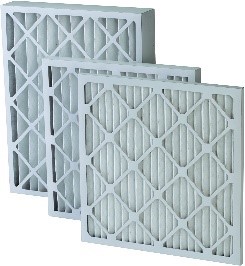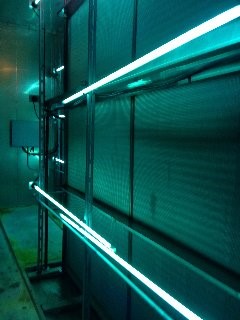HVAC Air Treatment with COVID-19
July 9, 2020 Newsroom
With the tri-state area reopening amidst the ongoing COVID-19 pandemic, many building owners and operators are looking for ways to mitigate the spread of the virus to building occupants. In addition to disinfection of commonly touched surfaces, social distancing, and screening procedures, the building’s HVAC system – the respiratory system of the building – has come under scrutiny as a potential mechanism for circulating contaminants throughout the building. Vapor droplets suspended in the air are the primary carriers of viruses, so their removal is key to slowing the spread of infection. While no one approach offers a silver bullet for stopping the spread of airborne particles, each will reduce the likelihood of transmission.
What Options Do I Have?
The American Society of Heating, Refrigeration and Air Conditioning Engineers (ASHRAE) sets the standards for indoor air quality. While ASHRAE’s list of recommendations for air treatment options pertain mostly to healthcare facilities with high risk of disease transmission, these approaches can be implemented by any building.
Filtration: Removing contaminants from the airstream to prevent them from recirculating throughout the system.
Dilution: Increasing the amount of outside (ventilation) air to reduce concentrations of contaminants.
Elimination: Deactivating or destroying living biological contagions in the air stream.
Environment: Maintaining the proper indoor ambient air conditions that are unfavorable for contagions.
Many of our clients are asking the question: What options do I go with? The answer is: It depends. Existing systems need to be evaluated to confirm that they are operating as designed and after any existing issues have been addressed, strategies for mitigating infectious spread can reviewed and implemented. Understanding the implications of the options below will illuminate an optimal approach within the constraints of the building’s HVAC system.
 Filtration: Most existing HVAC systems already have filters installed, so ensuring that these are being changed regularly and properly is important. Upgrading filters to higher MERV or HEPA levels with higher entrapment efficiencies for smaller particles can improve contaminant removal. However, it is important to understand the performance capabilities of the system before installing. Adding higher rated filters increases pressure drop through the system, which can result in poor airflow and may require modifications to the filter racks or fan operating parameters. Bi-polar ionization can be used to enhance filtration by generating ions that attach to contaminants, making them larger and more susceptible to filter capture, thus allowing for the use of lower filter ratings and avoiding airflow issues. Stand-alone filtration or ionizing units are effective for elevators.
Filtration: Most existing HVAC systems already have filters installed, so ensuring that these are being changed regularly and properly is important. Upgrading filters to higher MERV or HEPA levels with higher entrapment efficiencies for smaller particles can improve contaminant removal. However, it is important to understand the performance capabilities of the system before installing. Adding higher rated filters increases pressure drop through the system, which can result in poor airflow and may require modifications to the filter racks or fan operating parameters. Bi-polar ionization can be used to enhance filtration by generating ions that attach to contaminants, making them larger and more susceptible to filter capture, thus allowing for the use of lower filter ratings and avoiding airflow issues. Stand-alone filtration or ionizing units are effective for elevators.
Dilution: Buildings are required to provide ventilation air to occupied spaces, typically by mechanical means. By increasing the amount of outside or ventilation air to each system, the air in the zone is displaced and concentrations of contagions reduced. Ventilation air rates should be increased as much as possible, even to 100% if outdoor and indoor conditions allow. However, too much outside air could burden the system’s fixed heating or cooling capacity and result in uncomfortable space temperatures or worse, creating humidity levels that promote infection transmission. The proper balance of timing and duration of increased ventilation rates need to be carefully programmed into the system’s operation.
 Elimination: UV-C light is effective at inactivating many different pathogens such that they cannot replicate. While this approach is highly effective in static operations such as air coil sterilization and surface disinfection, there is a misconception that it will effectively deactivate viruses in a moving air stream. In most applications, the necessary modifications to provide the proper dosage to moving air in a single pass to deactivate all the entrained virus would be extensive and costly. Proper design of a UV-C system is necessary to ensure adequate dosages for the intended use of the installation.
Elimination: UV-C light is effective at inactivating many different pathogens such that they cannot replicate. While this approach is highly effective in static operations such as air coil sterilization and surface disinfection, there is a misconception that it will effectively deactivate viruses in a moving air stream. In most applications, the necessary modifications to provide the proper dosage to moving air in a single pass to deactivate all the entrained virus would be extensive and costly. Proper design of a UV-C system is necessary to ensure adequate dosages for the intended use of the installation.
Environment: Studies show that maintaining relative humidity levels between 40% and 60% reduce the risk of spreading airborne contagions. Viruses travel on atomized water droplets – larger droplets fall out of the air due to gravity or are captured by filters, but smaller droplets are more likely to stay airborne. Proper humidification can ensure that droplets do not evaporate to smaller particles and stay on the larger size, increasing their chance of filter capture. Additionally, the human body is less vulnerable to infection when humidity levels are above 40%. Adding humidification is a delicate process that requires an understanding of performance requirements and physical thermal envelope properties to avoid condensation or mold issues.
How do I get Started?
Understanding the physical and operational capabilities and limitations of your building’s HVAC system is necessary to determine which mitigation strategies are appropriate for the building. Considerations of space, capacity, installation cost, and operational/maintenance costs are important. Collado Engineering can assist you in reviewing and assessing existing systems and provide recommendations tailored to your specific building system and air treatment goals to reduce infection transmission and provide piece of mind for your occupants.